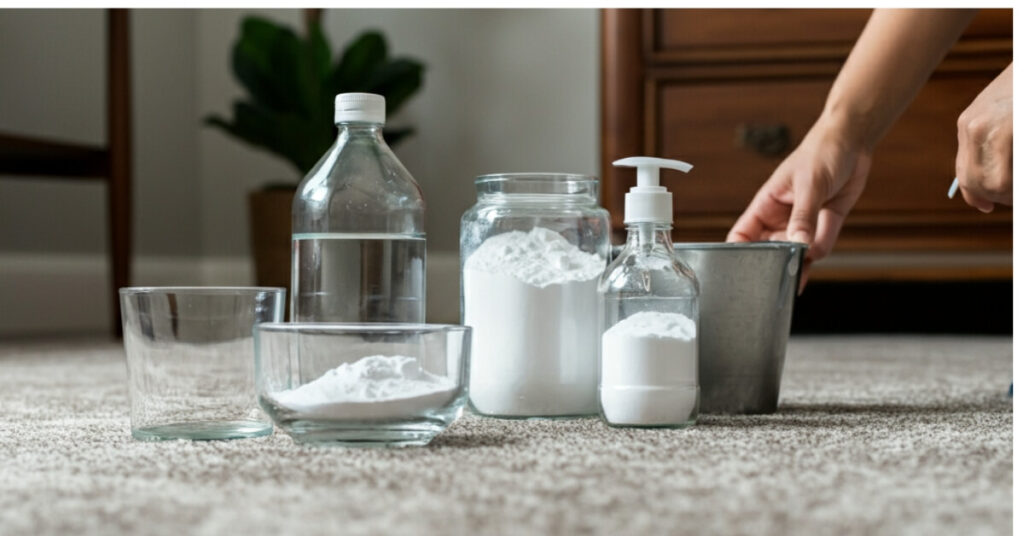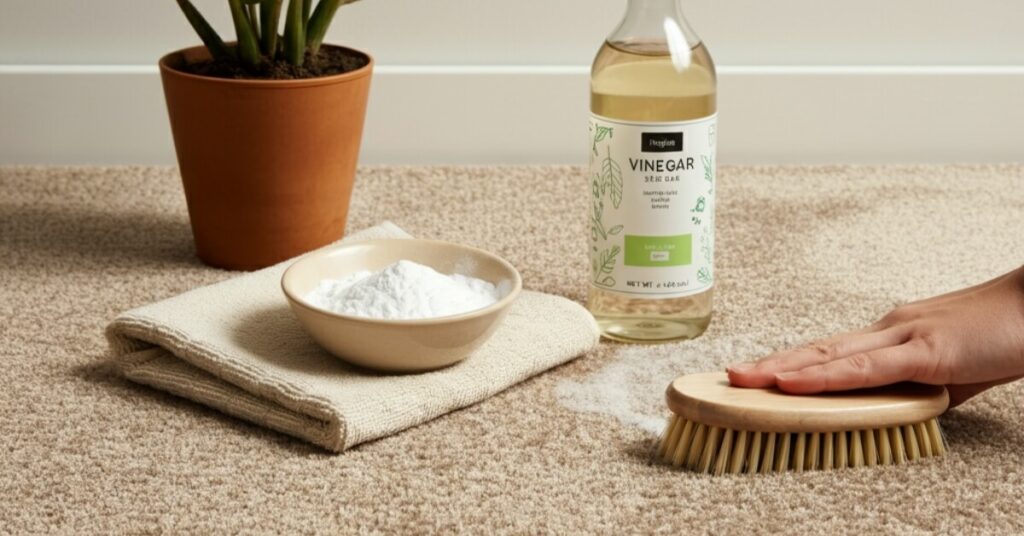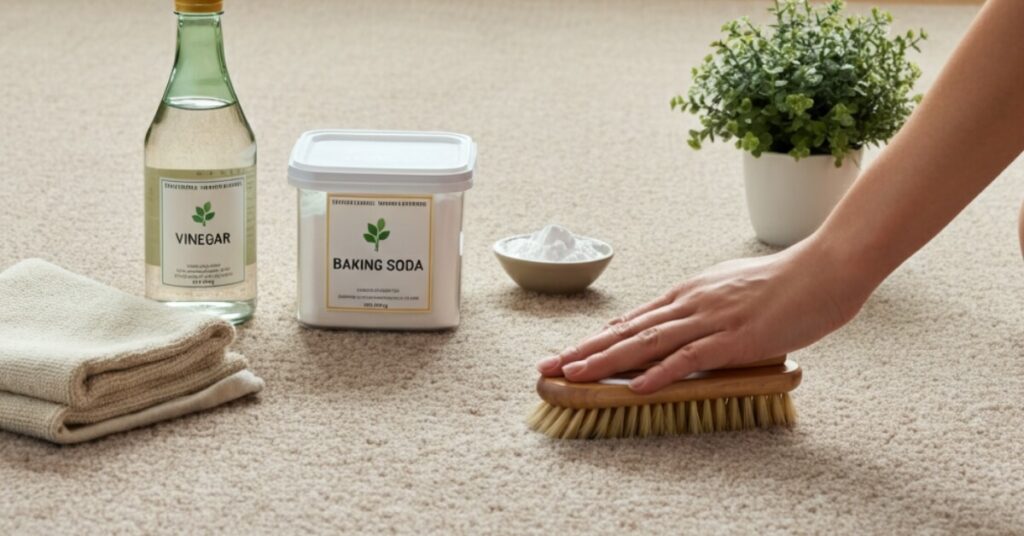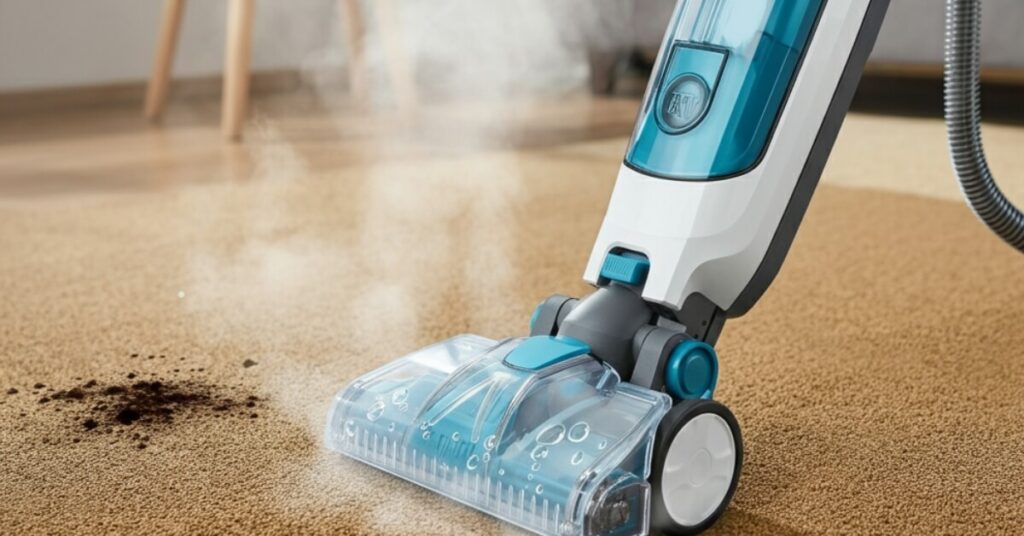As an Amazon Associate, I earn from qualifying purchases.
Store-bought carpet cleaners can drain your wallet and fill your home with harsh chemicals. Instead, you can create a powerful DIY homemade carpet cleaner using simple ingredients already sitting in your kitchen pantry. These natural solutions tackle tough stains, eliminate odors, and protect your family from unnecessary chemical exposure.
Making your own carpet cleaning solution offers complete control over what goes into your cleaning products. Furthermore, homemade cleaners cost a fraction of commercial alternatives while delivering impressive results. Whether you’re dealing with pet accidents, food spills, or general dirt buildup, the right DIY formula can restore your carpets to their former glory.
This comprehensive guide walks you through everything you need to know about creating effective homemade carpet cleaners. You’ll discover proven recipes, learn proper application techniques, and understand which ingredients work best for specific cleaning challenges.
Contents Overview
Why Choose a DIY Carpet Cleaner Over Store-Bought Options
Commercial carpet cleaners often contain synthetic fragrances, harsh surfactants, and volatile organic compounds that can trigger allergies or respiratory issues. Additionally, these products frequently cost $10-20 per bottle, making regular carpet maintenance expensive for budget-conscious households.
Cost Savings That Add Up
Creating homemade carpet cleaning solutions can reduce your cleaning expenses by up to 80%. Basic ingredients like white vinegar, baking soda, and liquid dish soap cost just pennies per use. Moreover, these multipurpose ingredients serve various household cleaning needs beyond carpet care.
A single bottle of commercial carpet cleaner might handle 2-3 cleaning sessions, while the same investment in DIY ingredients can last for months of regular use. This significant cost difference becomes even more apparent for large homes or families with pets and children who create frequent messes.
Natural Ingredients Mean Safer Homes
Homemade carpet cleaners rely on gentle, non-toxic ingredients that won’t harm children or pets. Unlike commercial products with lengthy warning labels, DIY solutions use food-grade components like vinegar and baking soda that pose minimal health risks.
These natural alternatives eliminate concerns about chemical residues left behind in carpet fibers. Consequently, your family can walk barefoot or play on freshly cleaned carpets without worrying about skin irritation or toxic exposure.
Customizable Solutions for Every Need
Store-bought cleaners offer one-size-fits-all formulas that may not address your specific carpet cleaning challenges. However, DIY recipes can be modified based on stain types, carpet materials, and personal preferences.
For instance, you can adjust ingredient ratios to create stronger solutions for stubborn stains or gentler formulas for delicate area rugs. This flexibility ensures optimal results while protecting your specific carpet investments.
How to Make DIY Homemade Carpet Cleaner (Step-by-Step)

Creating effective homemade carpet cleaning solutions requires understanding which ingredients work together and how to mix them properly. Most recipes use common household items that are readily available and affordable.
Essential Ingredients for Carpet Cleaning Success
White vinegar serves as the foundation for most DIY carpet cleaners due to its natural acidity, which breaks down dirt and neutralizes odors. Choose distilled white vinegar rather than colored varieties to avoid potential staining.
Baking soda acts as a gentle abrasive and odor absorber, making it perfect for lifting embedded dirt and eliminating persistent smells. This versatile ingredient also helps balance pH levels in cleaning solutions.
Liquid dish soap provides surfactant properties that help lift stains and suspend dirt particles for easy removal. Select clear, fragrance-free varieties to minimize residue and avoid potential carpet discoloration.
Hydrogen peroxide works as a natural bleaching agent and disinfectant, particularly effective for organic stains like blood, wine, or pet accidents. Always use 3% household-strength peroxide to prevent carpet damage.
Basic All-Purpose Carpet Cleaner Recipe of DIY Homemade Carpet Cleaner
Start with this versatile formula that handles most common carpet cleaning needs:
Ingredients:
- 1 cup warm water
- 1/4 cup white vinegar
- 1 tablespoon liquid dish soap
- 1 tablespoon baking soda
Instructions:
- Combine warm water and vinegar in a spray bottle or mixing bowl
- Add liquid dish soap and mix gently to avoid excessive foaming
- Gradually incorporate baking soda, stirring until fully dissolved
- Allow the mixture to settle for 2-3 minutes before use
Critical Pre-Cleaning Steps
Always test your homemade carpet cleaner on an inconspicuous area first. Apply a small amount to a hidden corner and wait 24 hours to check for color changes or fabric damage. This simple precaution prevents costly carpet replacement due to unexpected reactions.
Remove loose dirt and debris by thoroughly vacuuming the area before applying any cleaning solution. Pre-treatment ensures better penetration and prevents grinding dirt deeper into carpet fibers during the cleaning process.
Best Recipes for Different Carpet Needs

Different stains and carpet conditions require specialized cleaning approaches. These targeted formulas address specific challenges while maintaining safety and effectiveness.
General Cleaner for Everyday Maintenance
This mild formula works perfectly for routine carpet refreshing and light soil removal:
Ingredients:
- 2 cups warm water
- 1/2 cup white vinegar
- 2 tablespoons cornstarch
- 1 tablespoon salt
Mix ingredients until cornstarch dissolves completely. Apply with a spray bottle and work into carpet fibers using a soft brush. This gentle solution maintains carpet appearance without over-wetting or leaving residues.
Heavy-Duty Stain Remover
Tackle stubborn stains with this more aggressive homemade formula:
Ingredients:
- 1 cup warm water
- 1/2 cup hydrogen peroxide
- 2 tablespoons white vinegar
- 1 tablespoon liquid laundry detergent
Combine ingredients and apply directly to stained areas. Let the solution work for 10-15 minutes before blotting with clean towels. The hydrogen peroxide provides extra lifting power for set-in stains.
Odor-Neutralizing Formula
Eliminate persistent smells with this deodorizing carpet cleaner:
Ingredients:
- 1 cup baking soda
- 1/2 cup cornstarch
- 3-4 drops essential oil (optional)
Sprinkle this dry mixture over carpeted areas and let sit overnight. Vacuum thoroughly the next morning to remove both the powder and absorbed odors. This method works exceptionally well for smoke, cooking, or musty smells.
DIY Homemade Carpet Cleaner for Pet Stain and Odor Solution
Pet accidents require special treatment to eliminate both visible stains and lingering odors:
Ingredients:
- 1 cup warm water
- 1/2 cup white vinegar
- 1/4 cup hydrogen peroxide
- 2 tablespoons baking soda
- 1 teaspoon liquid enzyme detergent
The enzyme detergent breaks down protein-based stains while vinegar neutralizes ammonia odors. Apply generously and allow extended contact time for maximum effectiveness.
How to Use DIY Homemade Carpet Cleaner Safely and Effectively
Proper application techniques determine whether your homemade carpet cleaner delivers professional-quality results or leaves behind sticky residues and water damage.
Application Techniques That Work
Spray and Blot Method: Apply cleaning solution evenly across stained areas using a spray bottle. Work from outside edges toward the center to prevent stain spreading. Blot with clean, white towels rather than rubbing, which can damage carpet fibers.
Gentle Scrubbing Approach: For embedded dirt or older stains, use a soft-bristled brush to work the cleaning solution into carpet fibers. Move in circular motions with light pressure to avoid fraying or matting the carpet pile.
Steam Cleaning Enhancement: Add homemade solutions to steam cleaning machines for enhanced cleaning power. Dilute recipes by 50% when using mechanical equipment to prevent over-sudsing or machine damage.
Drying Time and Ventilation Requirements
Proper drying prevents mold growth and carpet damage after cleaning. Open windows and use fans to promote air circulation throughout treated areas. Most homemade carpet cleaners require 4-6 hours of drying time, depending on humidity levels and carpet thickness.
Avoid walking on damp carpets to prevent re-soiling and fiber damage. Place clean towels or plastic sheeting over cleaned areas if foot traffic cannot be avoided during drying periods. For the next step, check out our guide on how to dry carpet after cleaning.
Common Mistakes to Avoid to Apply DIY Homemade Carpet Cleaner
Never mix bleach with vinegar or other acidic ingredients, as this combination creates dangerous chlorine gas. Similarly, avoid combining hydrogen peroxide with vinegar in concentrated amounts, which can reduce cleaning effectiveness.
Over-wetting carpets can damage padding and subflooring while promoting mold growth. Use cleaning solutions sparingly and focus on thorough blotting rather than excessive application. Test colorfastness on colored or patterned carpets before using any hydrogen peroxide-based solutions. Some dyes may fade or change color when exposed to oxidizing agents.
Transform Your Carpet Cleaning Routine
DIY homemade carpet cleaners offer an affordable, safe, and effective alternative to commercial products. These natural solutions protect your family’s health while delivering impressive cleaning results that rival professional treatments.
Start with the basic all-purpose recipe and experiment with specialized formulas as needed. Remember to test all solutions in inconspicuous areas first, and always prioritize proper ventilation and drying times for best results.
Regular maintenance using homemade carpet cleaners extends carpet life, improves indoor air quality, and saves hundreds of dollars annually on professional cleaning services. Your carpets—and your budget—will thank you for making the switch to natural cleaning solutions.
Frequently Asked Questions
Can I use vinegar on all types of carpet?
No, avoid vinegar on natural fiber carpets like wool or silk, as acidity can damage these delicate materials. Test on synthetic carpets first to ensure colorfastness.
Will baking soda discolor my carpet?
No, baking soda is color-safe for most carpets. However, always vacuum thoroughly after use to prevent white residue buildup on dark-colored carpets.
How often should I clean my carpet with homemade solutions?
Use homemade cleaners for spot cleaning as needed and deep cleaning every 3-4 months. High-traffic areas may require monthly treatment.
Is DIY carpet cleaner safe for wool rugs?
No, use only water-based solutions specifically designed for wool. Avoid vinegar, hydrogen peroxide, or enzyme cleaners on natural fiber rugs.
Can I use essential oils in my carpet cleaner?
Yes, add 3-5 drops of essential oils to dry cleaning mixtures. Avoid adding oils to liquid solutions, as they may leave stains or attract dirt.
As an Amazon Associate, I earn from qualifying purchases.

